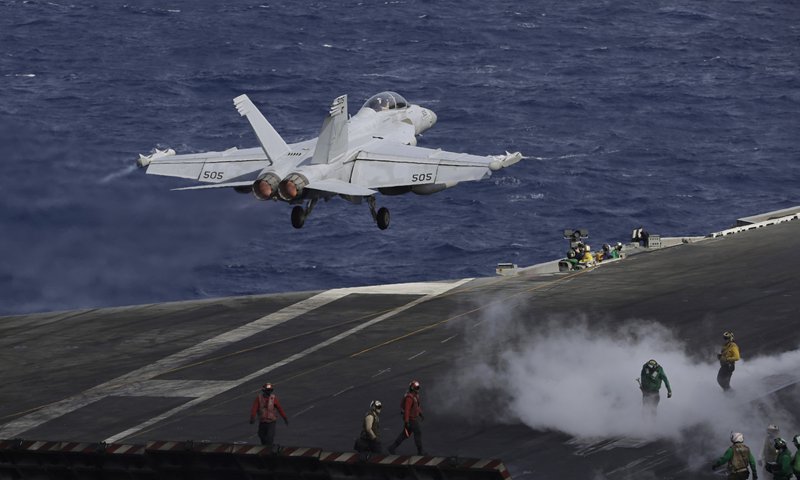
An F/A-18 Super Hornet fighter jet takes off on the deck of the US Navy USS Ronald Reagan in the South China Sea on Tuesday. China is allowing a US Navy aircraft carrier and its battle group to make a port call in Hong Kong Special Administrative Region after it turned down similar request in September. Photo: AP
The US has begun two "large-scale" military exercises. The first is a joint Indo-Pacific military exercise led by the US Indo-Pacific Command with the participation of Japan, Australia and the UK. The other is the "Large-Scale Exercise 2021" held by US Navy around the world and is reportedly the largest naval exercise since 1981. A US military scholar told media that it is intended to demonstrate to China and Russia that US naval forces can simultaneously meet challenges in the Black Sea, Eastern Mediterranean, South China Sea and East China Sea.
The US wants to awe China and Russia by flexing its muscles in a miscalculated move. China will hold military exercises from Friday to Tuesday in a vast area in the South China Sea between Hainan and Xisha Islands, as a response to the joint Indo-Pacific military exercise. Neither China nor Russia has the intention to compete for the command of the seas with the US, but both have the ability and determination to despise US coercion in areas that concern their core interests.
With current modern technologies, major powers have enough capability to destroy all targets within certain distances. The US Navy has built a global capability that helps sustain the loyalty of its allies. But if the US engages in a real war with China and Russia, its naval strength will not be able to survive. For big powers, navies are more of a showcase of strength and resolve. A gamble-like test is needed to see their real effect in modern wars. We hope such a test would never come.
From time to time, the US tries to show China and Russia that it is good at fighting wars and does not fear fighting a war with both. As for China, we must prove to the US and its allies that we love peace but we are not afraid of a war with the US in the Taiwan Straits and the South China Sea. We are determined and capable to fight until the end and defeat it if these areas are attacked by the US.
The US is showing off its military power around the world but China will not be swayed by this. If the US deploys its military forces to the South China Sea, no matter how many warships they send, they will only be like a group of rabbits partying obliviously while China's guns aim at them.
The South China Sea is an international waterway where countries enjoy freedom of navigation. However, it is located next to Chinese islands and reefs that are part of China's core interests. China will not tolerate for a long time the US playing a geopolitical card to showcase its hegemony.
If China's aircraft carrier strike groups constantly go in and out of the Caribbean Sea, encouraging countries there to fight against the US, would Washington tolerate it? It is time for the US to put itself in others' shoes and understand and respect the feelings of the Chinese people. China is no longer the country it was a century ago. Since the US views China as its top strategic competitor, it needs to follow the rules of the great powers game and keep a distance from China's strength.
We must also let the US' major allies in the Asia-Pacific region, especially Japan and Australia, know about such declaration. Their alliance with the US is formed historically but it has never targeted China before until recently. Japan and Australia in particular must be warned that they need to keep their distance and that it is dangerous for them to provoke China by following the steps of the US.
From now on, the greatest danger for Tokyo and Canberra is their own ambition and restlessness. If they are not convinced by China's rise and feel the need to help the US suppress China's growth, then they are turning themselves into enemies of Beijing and becoming a strategic front for the US to contain China. They need to take full responsibility for the consequences of such choice.
Let the US spend large amounts of money on its exercises in the Indo-Pacific region. Through its clumsy performance on epidemic prevention and disaster relief, we can see that the US is far less capable of mobilizing resources in extreme situations than most believed. China should intensively build new warships, upgrade fighter jets, produce more long range missiles that can strike naval targets, and establish the capacity to expand production of these weapons before and during real battles. These are China's strengths as an industrial power.
China also needs to further enhance its nuclear force and consolidate its ultimate deterrence against the US. This deterrence will strengthen the expectation that the US can only engage in a war of attrition with China that it can never win.




